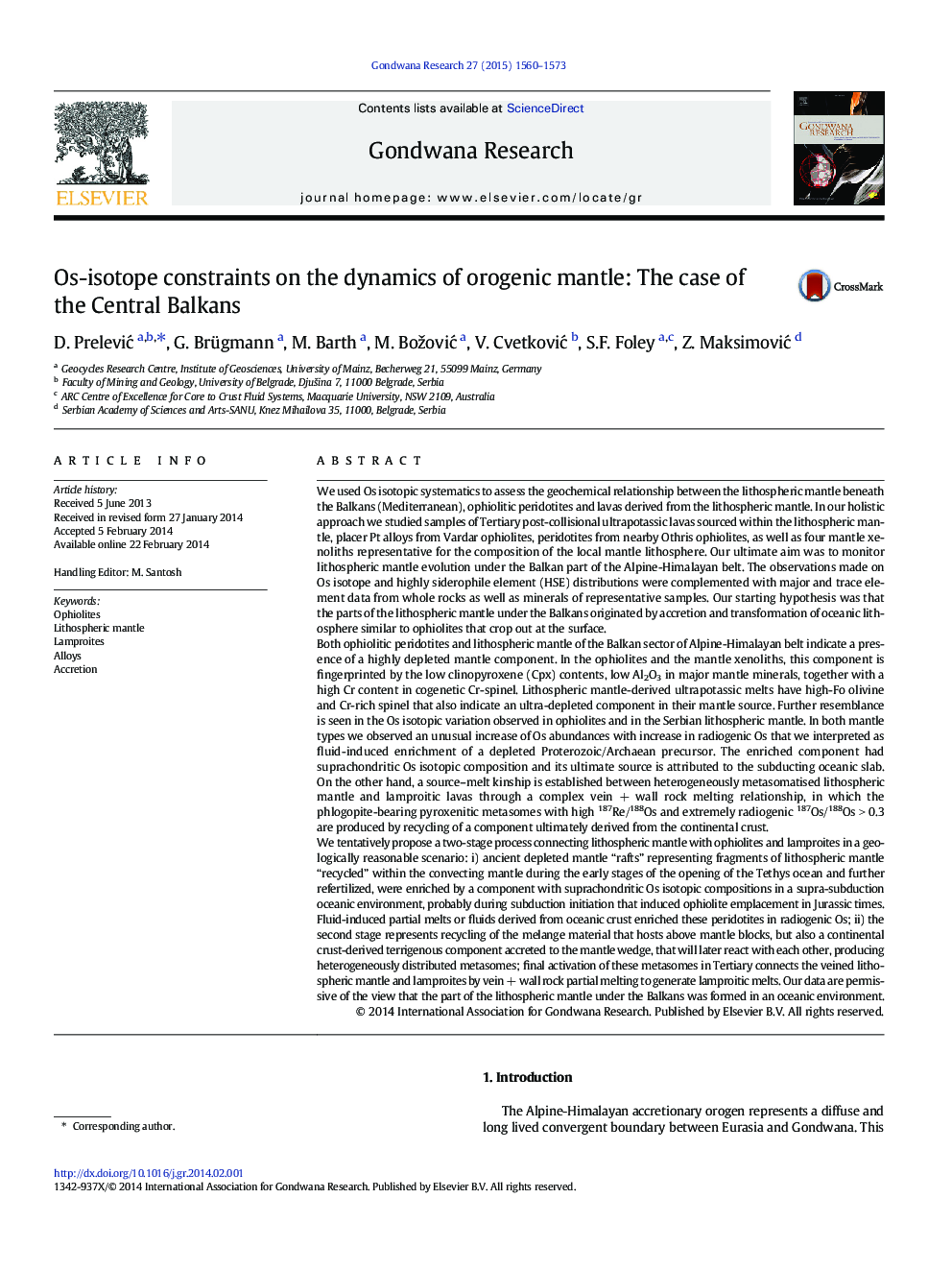| کد مقاله | کد نشریه | سال انتشار | مقاله انگلیسی | نسخه تمام متن |
|---|---|---|---|---|
| 6443396 | 1356352 | 2015 | 14 صفحه PDF | دانلود رایگان |

- We monitor lithospheric mantle development under the Balkan part of the Alpine-Himalayan belt.
- We combine Os isotopic and HSE as well as whole rock and mineral compositions of mantle xenoliths, Mesozoic ophiolites and lamproitic lavas sourced within the lithospheric mantle.
- Evidence suggests that the part of the orogenic mantle under the Balkans has experienced oceanic lithosphere development.
We used Os isotopic systematics to assess the geochemical relationship between the lithospheric mantle beneath the Balkans (Mediterranean), ophiolitic peridotites and lavas derived from the lithospheric mantle. In our holistic approach we studied samples of Tertiary post-collisional ultrapotassic lavas sourced within the lithospheric mantle, placer Pt alloys from Vardar ophiolites, peridotites from nearby Othris ophiolites, as well as four mantle xenoliths representative for the composition of the local mantle lithosphere. Our ultimate aim was to monitor lithospheric mantle evolution under the Balkan part of the Alpine-Himalayan belt. The observations made on Os isotope and highly siderophile element (HSE) distributions were complemented with major and trace element data from whole rocks as well as minerals of representative samples. Our starting hypothesis was that the parts of the lithospheric mantle under the Balkans originated by accretion and transformation of oceanic lithosphere similar to ophiolites that crop out at the surface.Both ophiolitic peridotites and lithospheric mantle of the Balkan sector of Alpine-Himalayan belt indicate a presence of a highly depleted mantle component. In the ophiolites and the mantle xenoliths, this component is fingerprinted by the low clinopyroxene (Cpx) contents, low Al2O3 in major mantle minerals, together with a high Cr content in cogenetic Cr-spinel. Lithospheric mantle-derived ultrapotassic melts have high-Fo olivine and Cr-rich spinel that also indicate an ultra-depleted component in their mantle source. Further resemblance is seen in the Os isotopic variation observed in ophiolites and in the Serbian lithospheric mantle. In both mantle types we observed an unusual increase of Os abundances with increase in radiogenic Os that we interpreted as fluid-induced enrichment of a depleted Proterozoic/Archaean precursor. The enriched component had suprachondritic Os isotopic composition and its ultimate source is attributed to the subducting oceanic slab. On the other hand, a source-melt kinship is established between heterogeneously metasomatised lithospheric mantle and lamproitic lavas through a complex vein + wall rock melting relationship, in which the phlogopite-bearing pyroxenitic metasomes with high 187Re/188Os and extremely radiogenic 187Os/188Os > 0.3 are produced by recycling of a component ultimately derived from the continental crust.We tentatively propose a two-stage process connecting lithospheric mantle with ophiolites and lamproites in a geologically reasonable scenario: i) ancient depleted mantle “rafts” representing fragments of lithospheric mantle “recycled” within the convecting mantle during the early stages of the opening of the Tethys ocean and further refertilized, were enriched by a component with suprachondritic Os isotopic compositions in a supra-subduction oceanic environment, probably during subduction initiation that induced ophiolite emplacement in Jurassic times. Fluid-induced partial melts or fluids derived from oceanic crust enriched these peridotites in radiogenic Os; ii) the second stage represents recycling of the melange material that hosts above mantle blocks, but also a continental crust-derived terrigenous component accreted to the mantle wedge, that will later react with each other, producing heterogeneously distributed metasomes; final activation of these metasomes in Tertiary connects the veined lithospheric mantle and lamproites by vein + wall rock partial melting to generate lamproitic melts. Our data are permissive of the view that the part of the lithospheric mantle under the Balkans was formed in an oceanic environment.
Journal: Gondwana Research - Volume 27, Issue 4, June 2015, Pages 1560-1573